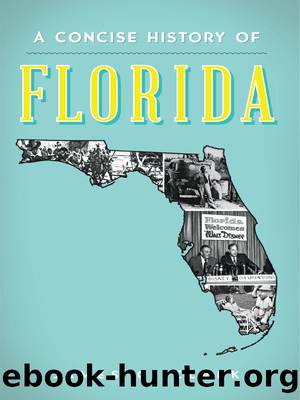A Concise History of Florida by James C. Clark

Author:James C. Clark [Clark, James C.]
Language: eng
Format: epub
Tags: History, United States, State & Local, South (AL; AR; FL; GA; KY; LA; MS; NC; SC; TN; VA; WV)
ISBN: 9781626196186
Google: ZvpEAQAACAAJ
Publisher: History Press
Published: 2014-01-15T02:47:54+00:00
Broward returned to steamboats, and in 1896, his steamboat, the Three Friends, ran guns to Cuban revolutionaries. His exploits made him famous, especially after the United States declared war on Spain in 1898.
In 1904, he ran for governor, campaigning against the big business interests. He was opposed by the railroad interests and the major newspapers. Broward promised to continue draining the Everglades. He won the primary by just a few hundred votes. As governor, Broward convinced President Theodore Roosevelt to support Everglades drainage.
After leaving the governorship, he ran for United States Senate, but lost to an old ally, Duncan Fletcher. In 1910, he did win a Senate seat, but he died before he could take office.
Albert Gilchrist might have had a career as a soldier, but he could not pass philosophy and flunked out of West Point. He became governor in 1909 and devoted his term to improving healthcare in the state. The stateâs youngest county is named for him, part of a most unusual political deal. When a county was being carved out of Alachua County, the plan was to name it for Woodrow Wilson, who had died the year before. But at the last minute, someone mentioned that Gilchrist was ill, and it was suggested that naming a county for the former governor would cheer him up.
Floridaâs most unusual governor was Sidney Catts, who served from 1917 to 1921. He was a Baptist minister in Alabama before moving to Florida in the early 1900s. In 1916, he ran for governor on a racist, anti-liquor and anti-Catholic platform. He told voters that Catholic convents were being used to hide guns, which the Church planned to use to overthrow the government. He seemed to have won the nomination for governor but was declared the loser in a controversial decision. Instead, he ran as the Prohibition Party candidate and won with 43 percent of the vote.
At his inauguration, he carried a revolver because he believed those he called the âpopeâs menâ were planning to assassinate him. He called blacks âan inferior race.â He was also the first governor to ride to his inauguration in an automobile.
The legislature ignored his outrageous proposals, which became more extreme. He claimed that the Pope was planning to move the Vatican to a small town near Tampa and close all Protestant churches. He ran for office several more times but always lost.
Governor Cary Hardee presided over Florida during its boom period, 1921 to 1925. The stateâs population was soaring, new towns were springing up and businesses were prospering. To make sure Florida continued to draw peopleâespecially wealthy peopleâHardee pushed through amendments to outlaw the income and inheritance taxes. He also outlawed the leasing of convicts to private businesses, which had been controversial and resulted in deaths.
He was replaced by John Martin, whose timing was terrible. The Florida boom became a bust the same year Martin took office. He had to spend much of his time trying to keep the boom going, traveling throughout the nation to deny there were any problems to an increasingly skeptical people.
Download
This site does not store any files on its server. We only index and link to content provided by other sites. Please contact the content providers to delete copyright contents if any and email us, we'll remove relevant links or contents immediately.
Giovanni's Room by James Baldwin(7199)
The Plant Paradox by Dr. Steven R. Gundry M.D(2548)
The Stranger in the Woods by Michael Finkel(2458)
Miami by Joan Didion(2327)
Wild: From Lost to Found on the Pacific Crest Trail by Cheryl Strayed(2215)
INTO THE WILD by Jon Krakauer(2157)
DK Eyewitness Top 10 Travel Guides Orlando by DK(2131)
Trail Magic by Trevelyan Quest Edwards & Hazel Edwards(2127)
Vacationland by John Hodgman(2092)
The Twilight Saga Collection by Stephenie Meyer(2087)
Nomadland by Jessica Bruder(2015)
Birds of the Pacific Northwest by Shewey John; Blount Tim;(1925)
The Last Flight by Julie Clark(1911)
Portland: Including the Coast, Mounts Hood and St. Helens, and the Santiam River by Paul Gerald(1885)
On Trails by Robert Moor(1854)
Deep South by Paul Theroux(1787)
Blue Highways by William Least Heat-Moon(1723)
Trees and Shrubs of the Pacific Northwest by Mark Turner(1682)
1,000 Places to See in the United States and Canada Before You Die (1,000 Places to See in the United States & Canada Before You) by Patricia Schultz(1609)
